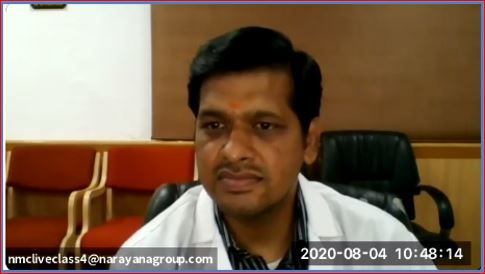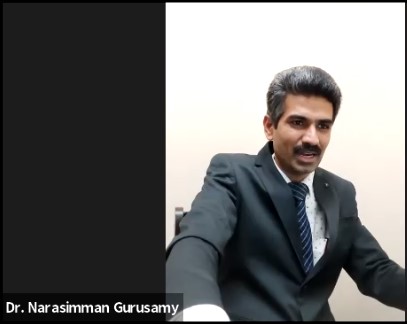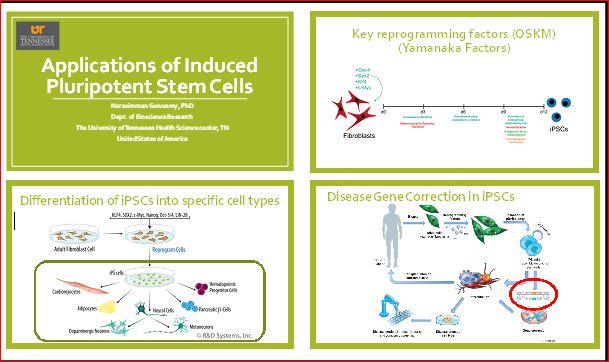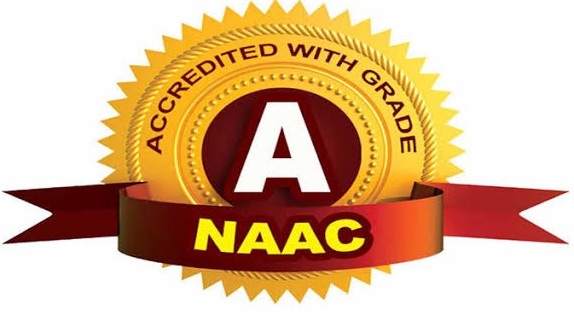International Webinar on
Therapeutic Applications of Human Induced Pluripotent Stem Cells
This event was organized by Narayana Translational Research Centre (NTRC) at Council Hall, Narayana Medical College Campus on 4th August, 2020 from 10 am to 11 am.
Panelist:
Patron: Dr. Surya Prakash Rao, Professor and Dean, Narayana Medical College, Nellore, A.P. India.
Speaker: Dr. Narasimman Gurusamy, University of Tennesse Health Science Centre (UTHSC), Memphis, Tennesse (TN), USA.
Convenor: Dr. Sivakumar Vijayaraghavalu, Professor and Head, Narayana Translational Research Centre (NTRC) has introduced the invited speaker to the participants and gave a brief overview about him which is as follows
Dr. Narasimman Gurusamy

Dr. Narasimman Gurusamy (Research Associate, UTHSC, USA), earned his Ph.D. from Niigata University of Pharmacy and Applied Life Sciences, Japan, followed by post-doctoral fellowship at the University of Connecticut Health Center, USA. Dr. Gurusamy served as a research faculty member at the Harvard Medical School, Brigham and Women’s Hospital, Boston, USA, and an Assistant Professor at the Department of Pharmacology, King Khalid University, Kingdom of Saudi Arabia. His research interests include epigenetic modifications during cellular growth and differentiation. He has published more than 40 research papers with citations over 2787.
Dr. Narasimman Gurusamy started his talk with the thanking note. The abstract of his talk is as follows –
Nobel Laureate
Dr. Shinya Yamanaka

Induced pluripotent stem cells (iPSCs) are produced by reprogramming of differentiated somatic cells by introducing four specific genes, namely – Myc, Oct3/4, Sox2 and Klf4.
Professor Shinya Yamanaka invented this technology in 2006 at Kyoto University, Japan. His incredible finding was published in one of the highly reputed journals in biological sciences, Cell (impact factor 36.2), the article is available in open archive (DOI 10.1016/j.cell.2006.07.024). This significance of this technology in healing human diseases and disorders was highly recognized by the scientific community and thereby resulted in Noble Prize (2012) award in very short span of 6 years, while most of the biological findings took decades to fetch the same.
Dr. Gurusamy further explained the advantages of iPSCs over the embryonic stem cells (ESCs).Due to its ability to multiply indefinetly and pluripotent nature ESCs were used to treat various diseases such as Parkinson’s disease, spinal cord injury and diabetes. However, need of human embryos and tissue rejection in patients poses major hurdle for ES cell therapy. These issues were addressed using Dr. Yamanaka’s iPSC technology, in which patients own somatic cells can be directed to have pluripotency and differentiated to the desired cell type for therapy. He explained the method of re-programming the somatic cells that includes cells from skin, peripheral blood, hair follicles and urine into iPSCs. Majorly two different methods were used to induce pluripotency in somatic cells viz., 1.integrative method, in which the genes inducing reprogramming factors were inserted into the somatic cells; these cells were used to understand the intricacies of regeneration, drug discovery, assessing gene therapy methods; 2. Non-integrative method involves use of small molecules and microRNAs, this method have less reprogramming efficiency on comparison to integrative method. However, among various vectors used to transfect the parental cells, episomal vectors (non-integrating system), a mixture of three vectors were shown to have high efficiency in generating transgene-free and virus-free iPSCs in a feeder free environment and are more suitable for cell – based therapies.
Dr. Gurusamy concluded his talk by thanking our organization and the organizers for creating a platform to talk about the iPSCs- a potential therapy for human diseases in near future. The presentation was followed by question (Q) & answer (A) session; questions from the participants were answered by him.
Q – Is there any study done to comparatively evaluate the safety and efficacy of polymers vectors over the viral vectors?
A: The viral vectors get integrated into the host genome and are regarded as unsafe and warrant human use. On the other hand the polymer vectors delivers the gene/factors that induce pluripotency into the host cell (non-integrative approach) and it will be safe and superior to the viral vectors. If the cells are to be transplanted into a patient for therapeutic purpose then the non-integrative approach will be best than using the integrative viral vectors.
Q – What will be the influence of microbiome/virome on transplanted iPSCs? Can you comment on their fate including survival and differentiation?
A: Good question; iPSC therapy is still in the clinical trial stage. Masayo Takashi, a Japanese ophthalmologist at RIKEN centre for developmental biology, successfully completed the first iPS transplant into the eye of a person with advanced macular degeneration. However the complications still persists. So the first goal is to effectively transplant these cells to people with different diseases and demonstrate its potential. I think as the field matures the researchers all over the globe may be studying the effect of microbiome and virome on the fate of iPS in vivo.
Post Q & A session the talk was concluded with a vote of thanks by Convenor. He thanked the speaker for delivering talk in a simple and clear manner so that even a non-scientific person also can understand and appreciate this technology. Then he thanked the organization – Narayana Medical College & Hospital and Dean- Dr. Surya Prakash Rao for his constant support and encouragement, because of that we were able to bring eminent speakers from other parts of the world, USA; with this note the session ended. Participants highly commended the talk.
The webinar was successful with 539 registrants.
 |
 |
 |


 CINEC
CINEC